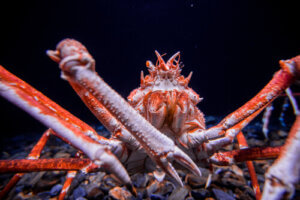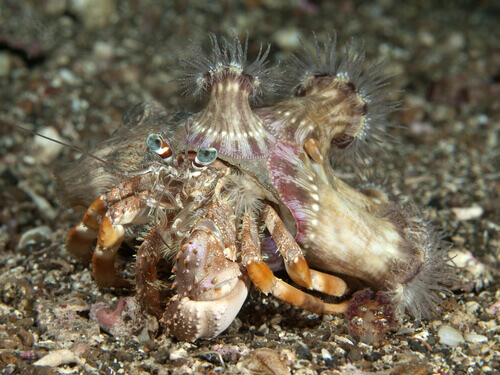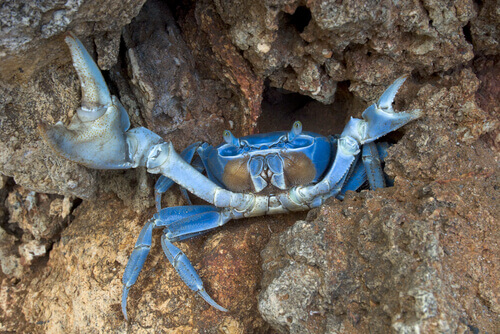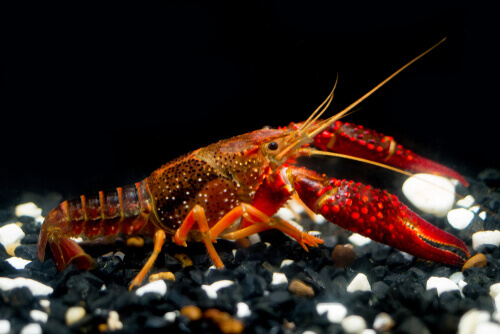5 Species of Crabs that Will Surprise You

An animal family that consists of over 4000 species is bound to be full of surprises. These crustaceans, known for their claws, shells, and the fact that they walk sideways, inhabit the floors of almost every ocean. Would you like to know more about some of the most impressive examples? Below, we’ll tell you about 5 species of crabs that will definitely surprise you.
5 crab species that will surprise you
Most species of crabs crawl along the ocean floor and only a few actually swim. What’s more, they have 4 legs on each side and 2 claws. These claws allow them to capture and handle food and fight over territory. Furthermore, during mating season, these claws allow male crabs to court female partners.
Just like other arthropods, these animals also have an exoskeleton which they shed on various occasions throughout their life. Several suborders and species of crabs exist around the world, and the most well-known are the following:
1. The Japanese spider crab
This crab belongs to the spider crab group, all of which have a triangular shell and long legs that can measure some 10 feet long. This species, Macrocheira kaempferi, lives in the depths of the Pacific Ocean, along with one of the Japanese coasts. Although it’s blind, it has hairs that are sensitive to waves, along with very sensitive ears.
Experts believe that the Japanese spider crab (pictured in the cover image of this article) can live approximately 100 years. However, in captivity, this timespan decreases to about 70 years. It’s also interesting to note that the Japanese spider crab’s claws can inject a special liquid in order to defend itself against predators.
2. The hermit crab
This name doesn’t refer to just one species of crabs, but rather several different species that share a specific quality. To be more specific, hermit crabs use conch shells in order to cover their abdomen, the softest part of their body. There are some 500 types of hermit crabs, and most of them are aquatic. However, there are also a few that live on land.

So, why do hermit crabs use conch shells for shelter? It’s because their exoskeleton only covers the front of their bodies. And, what’s even more interesting about these species, is that, as they grow, they have to “move” into a larger home.
Hermit crabs are scavengers, meaning they feed on dead creatures. However, their diet may also include some snails, worms, clams, larvae, and plants mixed with sand. As for their reproduction, female hermit crabs carry their eggs under their abdomen. Then, once fertilization takes place, they release the eggs into the sea.
3. The blue crab
The blue crab, or the Callinectes sapidus, is a crustacean that has 5 pairs of legs. Despite its name, the exoskeleton that covers its body is actually dark green. However, some males have a grayish-blue shell.

This crab is very fast and active. Its diet consists of fish, algae, mollusks, and other crustaceans. As for its average life expectancy, the blue crab can live for up to 8 years. And, just like the rest of its family, it’s oviparous. In fact, each spring and summer, females lay between 700,000 and 2 million eggs.
Blue crabs live in the Atlantic Ocean, all the way from Scotland to Argentina, but especially along the Gulf of Mexico. They prefer tropical coasts, bays, estuaries, river mouths, and coastal lakes that are no deeper than 6 and a half feet deep.
4. The Louisiana crawfish
This crab–Procambarus clarkii–inhabits the slow-moving rivers and cold waters of the southeastern part of the United States. Given its ability to grow rapidly and withstand droughts, this species is considered invasive. What’s more, the Louisiana crawfish can live for around 5 years and feeds on just about anything… dead creatures, animals, or plants.

5. The spider crab
In this final case, it’s difficult to know whether you’re looking at a crab and or a spider that can swim. This crustacean is a relative of the Japanese spider crab, but only because of its triangular shape and long legs.

As for its size, this species only measures up to about 4 inches, and its body is dark brown with gray claws. It feeds on worms and crustaceans and inhabits the reefs and rocks of the Atlantic Ocean–from the United States down to Argentina–in order to camouflage itself without any problems.
An animal family that consists of over 4000 species is bound to be full of surprises. These crustaceans, known for their claws, shells, and the fact that they walk sideways, inhabit the floors of almost every ocean. Would you like to know more about some of the most impressive examples? Below, we’ll tell you about 5 species of crabs that will definitely surprise you.
5 crab species that will surprise you
Most species of crabs crawl along the ocean floor and only a few actually swim. What’s more, they have 4 legs on each side and 2 claws. These claws allow them to capture and handle food and fight over territory. Furthermore, during mating season, these claws allow male crabs to court female partners.
Just like other arthropods, these animals also have an exoskeleton which they shed on various occasions throughout their life. Several suborders and species of crabs exist around the world, and the most well-known are the following:
1. The Japanese spider crab
This crab belongs to the spider crab group, all of which have a triangular shell and long legs that can measure some 10 feet long. This species, Macrocheira kaempferi, lives in the depths of the Pacific Ocean, along with one of the Japanese coasts. Although it’s blind, it has hairs that are sensitive to waves, along with very sensitive ears.
Experts believe that the Japanese spider crab (pictured in the cover image of this article) can live approximately 100 years. However, in captivity, this timespan decreases to about 70 years. It’s also interesting to note that the Japanese spider crab’s claws can inject a special liquid in order to defend itself against predators.
2. The hermit crab
This name doesn’t refer to just one species of crabs, but rather several different species that share a specific quality. To be more specific, hermit crabs use conch shells in order to cover their abdomen, the softest part of their body. There are some 500 types of hermit crabs, and most of them are aquatic. However, there are also a few that live on land.

So, why do hermit crabs use conch shells for shelter? It’s because their exoskeleton only covers the front of their bodies. And, what’s even more interesting about these species, is that, as they grow, they have to “move” into a larger home.
Hermit crabs are scavengers, meaning they feed on dead creatures. However, their diet may also include some snails, worms, clams, larvae, and plants mixed with sand. As for their reproduction, female hermit crabs carry their eggs under their abdomen. Then, once fertilization takes place, they release the eggs into the sea.
3. The blue crab
The blue crab, or the Callinectes sapidus, is a crustacean that has 5 pairs of legs. Despite its name, the exoskeleton that covers its body is actually dark green. However, some males have a grayish-blue shell.

This crab is very fast and active. Its diet consists of fish, algae, mollusks, and other crustaceans. As for its average life expectancy, the blue crab can live for up to 8 years. And, just like the rest of its family, it’s oviparous. In fact, each spring and summer, females lay between 700,000 and 2 million eggs.
Blue crabs live in the Atlantic Ocean, all the way from Scotland to Argentina, but especially along the Gulf of Mexico. They prefer tropical coasts, bays, estuaries, river mouths, and coastal lakes that are no deeper than 6 and a half feet deep.
4. The Louisiana crawfish
This crab–Procambarus clarkii–inhabits the slow-moving rivers and cold waters of the southeastern part of the United States. Given its ability to grow rapidly and withstand droughts, this species is considered invasive. What’s more, the Louisiana crawfish can live for around 5 years and feeds on just about anything… dead creatures, animals, or plants.

5. The spider crab
In this final case, it’s difficult to know whether you’re looking at a crab and or a spider that can swim. This crustacean is a relative of the Japanese spider crab, but only because of its triangular shape and long legs.

As for its size, this species only measures up to about 4 inches, and its body is dark brown with gray claws. It feeds on worms and crustaceans and inhabits the reefs and rocks of the Atlantic Ocean–from the United States down to Argentina–in order to camouflage itself without any problems.
This text is provided for informational purposes only and does not replace consultation with a professional. If in doubt, consult your specialist.








